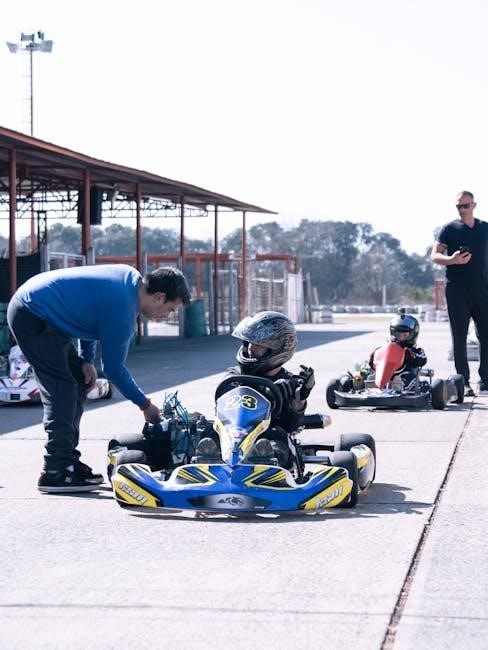Sena Bluetooth helmets combine innovative technology with safety, offering seamless communication, music streaming, and voice command functionality. Designed for cyclists and motorcyclists, these helmets enhance riding experiences with cutting-edge features.
1.1 Overview of Sena Bluetooth Helmet Technology
Sena Bluetooth helmets integrate advanced communication systems, featuring Bluetooth 4.1 technology with profiles like A2DP, AVRCP, HFP, and HSP. They support voice commands, Mesh Intercom for group conversations, and compatibility with smartphones, GPS, and MP3 devices. The technology ensures high-quality audio, seamless connectivity, and intuitive controls, enhancing rider safety and convenience. These helmets are designed for motorcyclists and cyclists seeking reliable, hands-free communication on the go.
1.2 Importance of Bluetooth Communication in Helmets
Bluetooth communication in helmets is a game-changer for riders, enabling hands-free calls, music streaming, and GPS navigation. It enhances safety by minimizing distractions, keeping eyes on the road. Riders can connect with fellow cyclists or motorcyclists via intercom systems, fostering group communication. This technology ensures seamless connectivity, reducing risks and improving the overall riding experience.
Unboxing and Preparing the Helmet
Unboxing your Sena helmet reveals the main unit, speakers, and microphone. Preparation involves installing these components, ensuring a snug fit for optimal performance and safety.
2.1 What’s Included in the Package
The Sena Bluetooth helmet package includes the main unit, high-quality speakers, a flexible microphone, mounting accessories, a USB charging cable, and a detailed user manual. Additional items like ear pads and installation guides may also be provided to ensure a seamless setup experience for users.
2.2 Initial Setup and Preparing the Helmet for Use
Start by reading the user manual to understand the helmet’s features and setup process. Charge the Bluetooth module fully before first use. Install the speakers and microphone according to the guide, ensuring proper alignment and secure fitting. Power on the helmet and enter pairing mode to connect with your Bluetooth device, following the manual’s instructions for a successful setup.

Installing the Bluetooth System
Prepare the helmet by aligning the Bluetooth module with the designated slots. Route the cables securely, ensuring proper connection and stability for optimal performance.
3.1 Preparing the Helmet for Installation
Start by removing any protective coverings and ensuring the helmet is clean. Locate the designated mounting areas for the Bluetooth components. Gently pull back the rubber padding to access the cable routing channels. This step ensures a secure and seamless installation process for the Bluetooth system.
3.2 Step-by-Step Installation Guide
Start by removing the helmet’s inner pads to access the mounting areas. Route the Bluetooth module’s cable through the designated channels, ensuring proper fitment. Secure the module firmly using the provided adhesive or clips. Reattach the pads and ensure all components are tightly fastened. Finally, power on the system and pair it with your desired devices for optimal performance.
3.3 Securing the Bluetooth Module
Ensure the Bluetooth module is firmly attached using adhesive strips or screws provided. Tuck excess cable into the helmet’s padding to prevent movement. Check all connections for stability and durability. Secure any loose wires with cable ties to avoid interference during rides. Properly securing the module ensures reliable performance and longevity of the system.
Pairing the Helmet with Bluetooth Devices
4.1 Pairing with a Mobile Phone
To pair your Sena Bluetooth helmet with a mobile phone, enable Bluetooth on your phone and put the helmet in pairing mode by holding the center button. The LED will flash red and blue. Select the helmet’s name in your phone’s Bluetooth settings. Use the Sena app for QR code pairing or follow manual pairing steps. Ensure a stable connection for calls and music streaming.
4.2 Pairing with Other Sena Bluetooth Headsets
To pair your Sena Bluetooth helmet with other Sena headsets, enable intercom mode on both devices. Press and hold the intercom button until the LED flashes blue. Select the helmet’s name from the available devices list. The connection is confirmed when the LED turns solid blue. Up to three Sena headsets can be paired for seamless group communication on the go.
4.3 Pairing with GPS and MP3 Devices
Pairing your Sena Bluetooth helmet with GPS and MP3 devices allows for navigation and music streaming. Enable Bluetooth on your GPS or MP3 device. Put your helmet in pairing mode by pressing the center button until the LED flashes red and blue. Select the helmet’s name from the device’s list. Once connected, you can enjoy audio navigation and music through the helmet’s speakers seamlessly.

Charging and Battery Care
Charge your Sena Bluetooth helmet using the provided USB port, typically taking 3 hours. Avoid overcharging to prolong battery life. Regularly clean the charging port.
5.1 How to Charge the Helmet
To charge your Sena Bluetooth helmet, locate the USB-C port on the control unit. Use the provided USB-C cable and plug it into a compatible charger or computer. The LED light will turn red during charging and green when fully charged, typically within 3 hours. Avoid overcharging to maintain battery health.
5.2 Battery Life and Maintenance Tips
The Sena Bluetooth helmet offers up to 10 hours of talk time and 12 days of standby. To maintain battery health, avoid overcharging and store the helmet in a cool, dry place. Clean the charging port regularly with a soft cloth and ensure it’s dry before charging. Replace the battery if performance decreases after 500 charge cycles.
Operating the Helmet’s Controls
The helmet features intuitive controls, including a center button for power and pairing, volume adjustment via the + and ─ buttons, and LED indicators for status updates.
6.1 Button Functions and Layout
The Sena Bluetooth helmet’s control panel is strategically designed for easy access. The center button manages power, pairing, and voice commands. The + and, buttons adjust volume, while the LED light indicates power, pairing, and charging status. This layout ensures riders can operate the helmet without distractions, keeping hands on the handlebars for safety.
6.2 Powering On/Off and Volume Adjustment
To power on, press and hold the center button until the LED lights up blue. For power off, hold the center button until the LED flashes red. Volume adjustment is done using the + and — buttons. Press and hold to skip tracks or answer calls. The LED indicates pairing (blue/red) and charging (red/green) statuses, ensuring intuitive control while riding;

Sound Quality and Audio Settings
Sena helmets deliver high-fidelity sound with clear audio and deep bass. Advanced noise cancellation ensures crisp communication. Users can customize equalizer settings via the Sena app for optimal listening experiences.
7.1 Adjusting Volume and Sound Settings
Adjust the volume using the center button or via the Sena Utility App. Customize sound settings like bass, treble, and balance for personalized audio. Enable noise cancellation to enhance clarity. Access equalizer modes through the app to optimize music and voice quality. Ensure optimal audio performance by tweaking settings based on your riding environment and preferences.
7.2 Using the Boom Audio Bluetooth Device Manager
The Boom Audio Bluetooth Device Manager simplifies managing your Bluetooth connections. It allows pairing with multiple devices, adjusting audio settings, and customizing preferences. Use the app to monitor battery life, update firmware, and troubleshoot connectivity issues. This tool enhances your Sena helmet experience by providing centralized control over all Bluetooth features, ensuring seamless communication and entertainment on the go.
Troubleshooting Common Issues
Troubleshoot connectivity problems by resetting the Bluetooth module or clearing paired devices. Ensure stable connections and resolve audio issues by checking speaker and microphone functionality for optimal performance.
8.1 Resolving Bluetooth Connectivity Problems
To resolve Bluetooth issues, restart the helmet and device, ensuring they are in pairing mode. Check for firmware updates and clear old pairings. If problems persist, reset the helmet by holding the center button for 10 seconds while powered on. This restores default settings and often fixes connectivity problems. Ensure devices are within range for stable connections.
8.2 Fixing Audio and Microphone Issues
For audio issues, ensure speakers are clean and free from debris. Adjust volume settings and check for firmware updates. If the microphone is not working, inspect for blockages and ensure it’s properly secured. Reset the helmet if problems persist. Refer to the manual for detailed troubleshooting steps and guidelines to restore optimal audio and microphone functionality.

Safety Tips and Precautions
Always wear the helmet securely, ensuring a proper fit. Avoid distractions while riding and follow traffic rules. Regularly inspect the helmet for damage and clean it as instructed to maintain functionality and safety.
9.1 Safe Usage Guidelines
Ensure the helmet fits securely and is worn correctly to prevent shifting during use. Avoid distractions like excessive volume or complex menu navigation while riding. Keep the microphone clear of obstructions for optimal voice clarity. Regularly inspect the helmet and Bluetooth components for damage or wear. Follow all traffic laws and maintain situational awareness at all times. Clean the helmet as instructed to maintain functionality and hygiene. Store the helmet in a cool, dry place when not in use to preserve its integrity.
9.2 Avoiding Potential Hazards
Prevent moisture exposure to electronic components to avoid malfunctions. Never modify the helmet or tamper with its Bluetooth system, as this may compromise safety and void the warranty. Ensure all cables are securely routed to prevent snagging or damage. Avoid using the helmet in extreme temperatures, as this can affect battery performance and Bluetooth connectivity. Regular software updates are essential for maintaining optimal functionality and security. Always follow the manufacturer’s guidelines for charging and storage to prevent battery degradation. Be mindful of overexposure to high volumes, which can lead to hearing damage. Keep the helmet away from children to avoid accidental damage or improper use. Ensure proper fit to minimize distractions while riding. By adhering to these precautions, you can ensure a safe and enjoyable experience with your Sena Bluetooth helmet. Proper care and adherence to safety guidelines are crucial for maintaining both the helmet’s performance and your personal safety on the road.
Updating Firmware and Software
Regular firmware updates enhance performance, fix issues, and add features. Use the Sena Smartphone App to download and install the latest software for your helmet.
10.1 Using the Sena Smartphone App
The Sena Smartphone App allows users to manage firmware updates, adjust settings, and monitor battery life. It provides step-by-step guides for pairing devices and troubleshooting. The app ensures optimal performance by keeping the helmet’s software up-to-date, enhancing features like Bluetooth connectivity and audio quality. Regular app updates also introduce new functionalities, making it essential for maximizing the helmet’s capabilities.
10.2 Updating Firmware for Enhanced Performance
Updating the firmware ensures your Sena Bluetooth helmet performs at its best. Use the Sena Smartphone App to check for updates, then follow in-app instructions to download and install the latest version. A fully charged battery is recommended. Updates may improve connectivity, audio quality, and add new features. Avoid interrupting the process to prevent system issues. Regular updates keep your helmet optimized for seamless functionality and enhanced user experience.
Maintenance and Cleaning
Regularly clean your Sena Bluetooth helmet using a soft cloth and mild detergent. Avoid harsh chemicals. Inspect Bluetooth components for damage and ensure proper storage when not in use.
11.1 Cleaning the Helmet and Bluetooth Components
Regular maintenance ensures longevity. Use a soft, dry cloth to wipe away dust. For tougher spots, dampen a cloth with mild soap, avoiding harsh chemicals. Gently clean Bluetooth components with a cotton swab. Dry thoroughly to prevent moisture damage. Store the helmet in a cool, dry place, away from direct sunlight, to maintain its condition and functionality.
11.2 Regular Maintenance Tips
Regular maintenance ensures optimal performance. Charge the battery fully after rides to prevent degradation. Inspect pads for wear and tear, replacing them as needed. Check Bluetooth module connections for stability. Avoid exposing the helmet to extreme temperatures or moisture. Store in a cool, dry place when not in use. Update firmware periodically for enhanced functionality and security.
Model-Specific Instructions
This section provides tailored guidance for specific Sena helmet models, ensuring optimal performance and functionality for each design, from installation to advanced Bluetooth connectivity setups.
12.1 Sena R1 EVO Smart Cycling Helmet
The Sena R1 EVO is a cutting-edge smart cycling helmet featuring integrated Bluetooth technology. It includes a built-in microphone, speakers, and LED indicators. Designed for cyclists, it offers voice command functionality, seamless music streaming, and hands-free calls. The helmet supports up to three other Sena headsets for group communication. Installation involves securing the Bluetooth module and pairing devices via the Sena app. Regular firmware updates ensure optimal performance and enhanced features.
12.2 Sena Savage Bluetooth Helmet
The Sena Savage is an open-face Bluetooth helmet designed for motorcyclists. It features integrated controls, speakers, and a discreet microphone in the brow area. The helmet supports Bluetooth 4.1, offering seamless communication with up to three other Sena headsets. The manual provides detailed instructions for installation, pairing, and troubleshooting. Regular updates via the Sena app ensure enhanced performance and compatibility with various devices.
Additional Features and Accessories
Sena Bluetooth helmets offer additional features like the Sena Utility App for firmware updates and customizable settings. Compatible accessories enhance functionality, ensuring optimal performance and rider convenience.
13.1 Using the Sena Utility App
The Sena Utility App provides essential tools for managing your Bluetooth helmet. It allows users to update firmware, customize settings, and troubleshoot issues. The app offers a user-friendly interface to adjust audio preferences, pair devices, and monitor battery life. Regular updates ensure optimal performance and compatibility with the latest features. Download it from Google Play or the App Store for enhanced functionality.
13.2 Compatible Accessories and Enhancements
Sena Bluetooth helmets support a range of compatible accessories, enhancing functionality and comfort. Users can add external microphones, upgraded speakers, or specialized mounting systems. Optional visors, ear pads, and chin guards improve versatility. These enhancements ensure a tailored experience, optimizing both safety and performance for motorcyclists and cyclists. Explore Sena’s official accessories to elevate your helmet’s capabilities and satisfaction.

Advanced Settings and Customization
Maximize your Sena Bluetooth helmet experience with advanced customization options. Use the Sena Utility App to adjust audio settings, configure communication preferences, and optimize performance for a tailored ride.
14.1 Configuring the Helmet for Optimal Performance
Configure your Sena Bluetooth helmet for optimal performance by adjusting noise control, audio balance, and intercom settings. Use the Sena Utility App to fine-tune preferences, ensuring seamless connectivity with phones, GPS, or MP3 devices. Regularly update firmware and customize audio profiles for enhanced sound quality and communication clarity during rides.
14.2 Customizing Audio and Communication Settings
Customize your Sena helmet’s audio and communication settings using the Sena Utility App. Adjust volume, bass, and treble for personalized sound. Enable voice commands, set up custom intercom groups, and fine-tune microphone sensitivity. These adjustments enhance communication clarity and audio quality, ensuring a tailored experience for music, calls, and intercom interactions while riding.
Maximize your Sena Bluetooth helmet experience by following the guide, ensuring proper setup, and regular updates. Safe riding and enjoyable communication are just a headset away!
15.1 Maximizing Your Sena Bluetooth Helmet Experience
Maximize your Sena Bluetooth helmet experience by optimizing settings, maintaining battery health, and staying updated with the latest firmware. Regular cleaning and proper storage extend longevity, ensuring reliable communication and audio performance. Use compatible accessories and explore advanced features like Mesh Intercom for enhanced connectivity. Always refer to the user manual for troubleshooting and customization tips to ensure a seamless riding experience.
